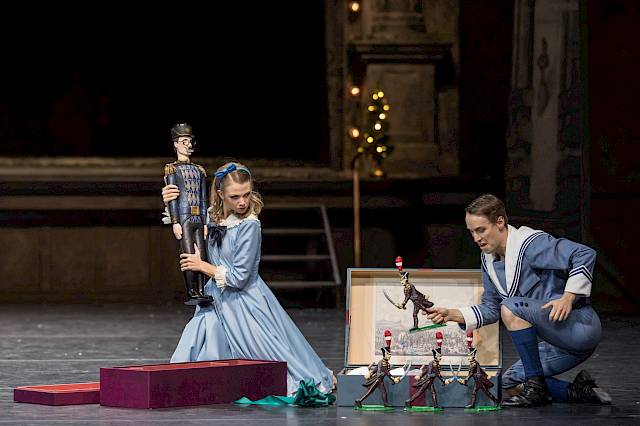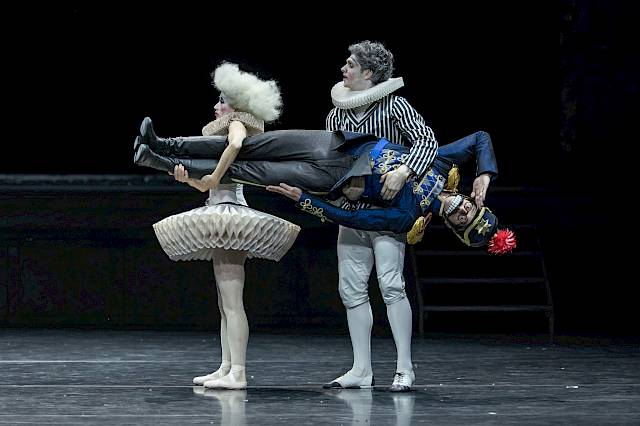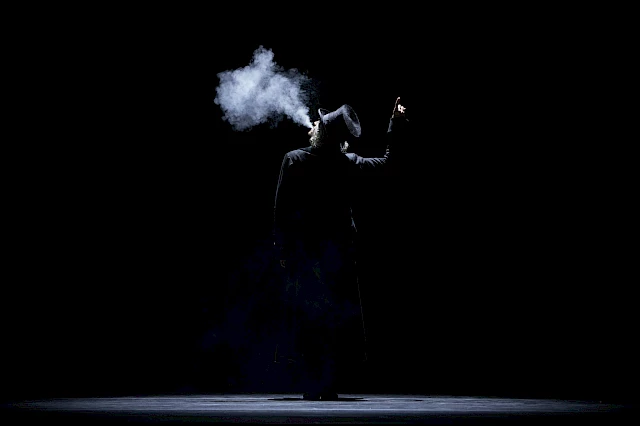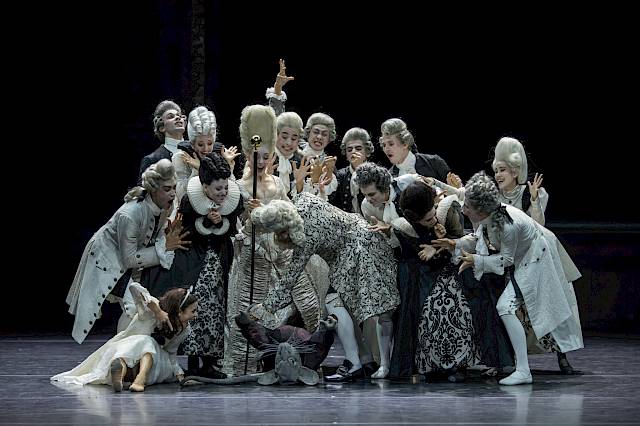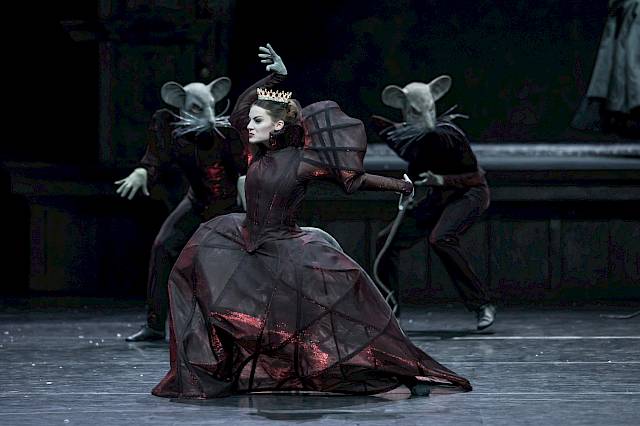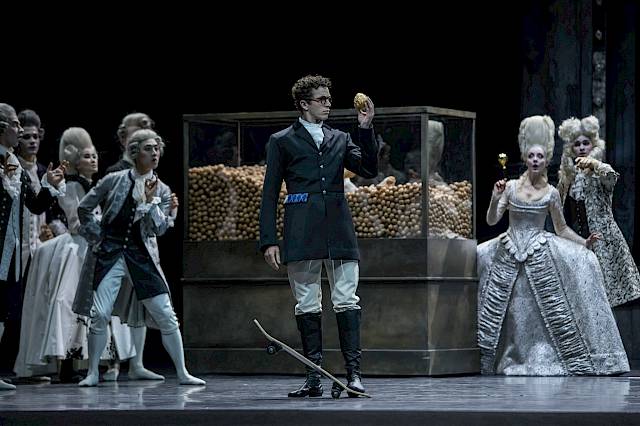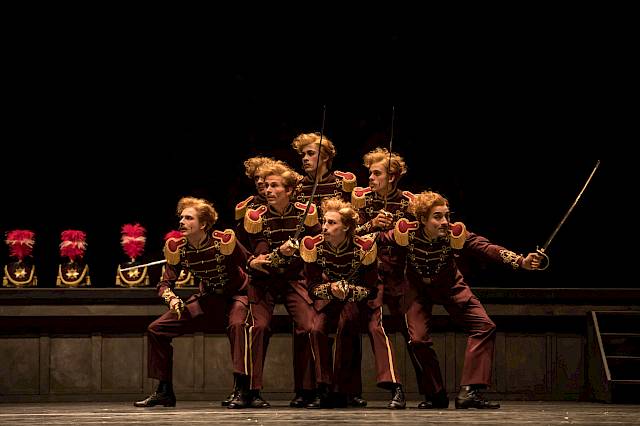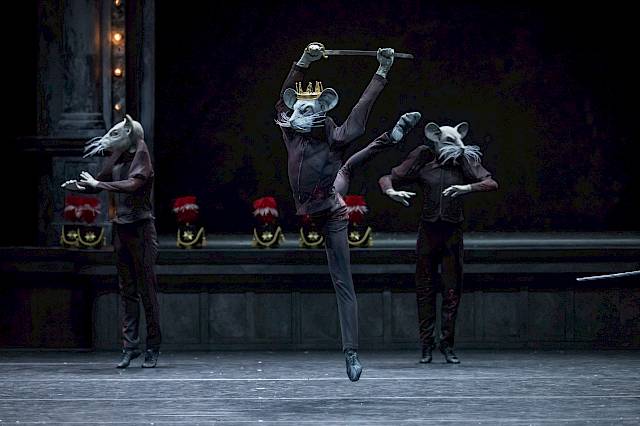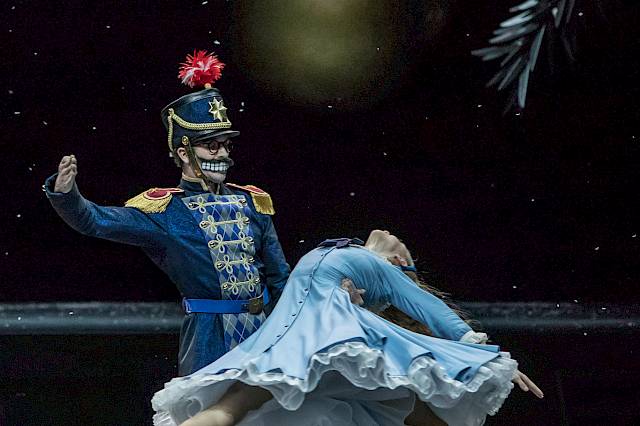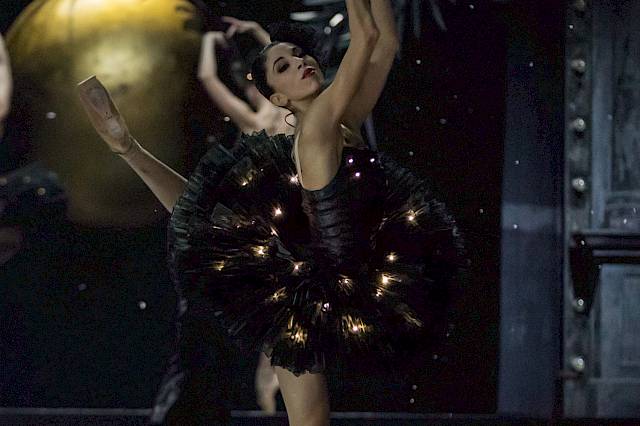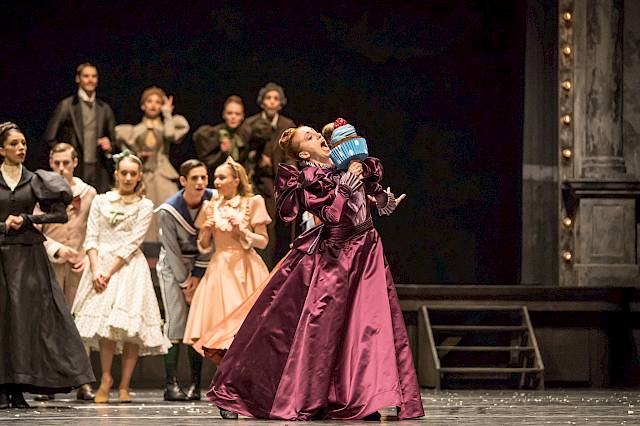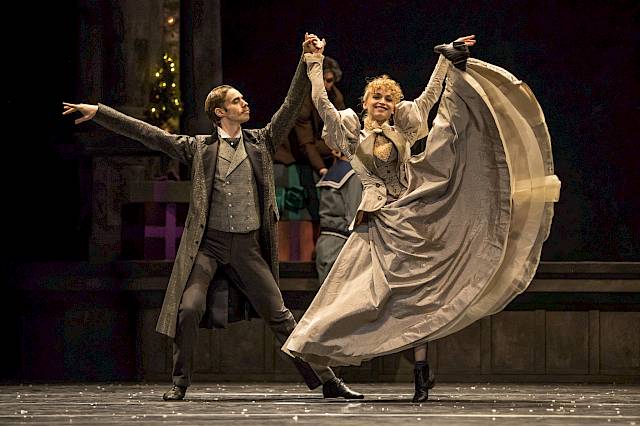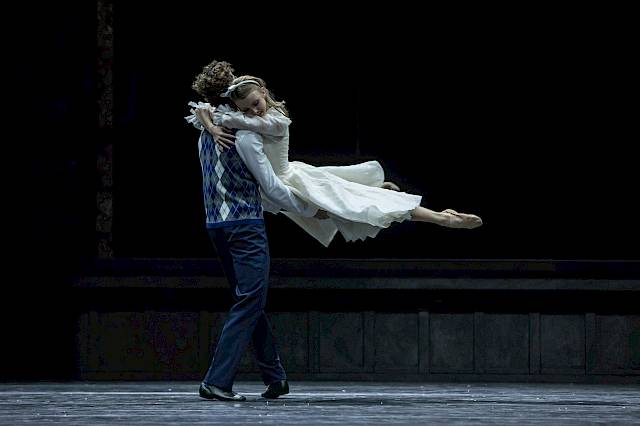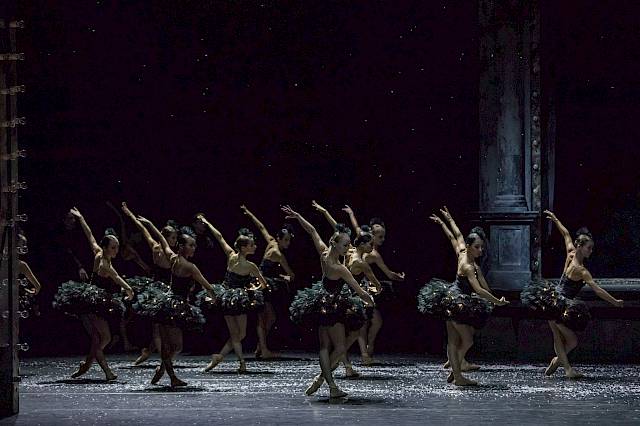Nussknacker und Mausekönig
Ballet by Christian Spuck after the eponymous fairy tale by E.T.A. Hoffmann
New version of the scenario by Claus Spahn
Music by Pjotr Tschaikowski (1840-1893)
Duration 2 H. 15 Min. incl. intermission after 1st part after approx. 1 H. Introduction 45 min before the performance.
Partner Ballett Zürich 
Past performances
November 2022
December 2022
Good to know
Nussknacker und Mausekönig
Abstract
Nussknacker und Mausekönig
The Nutcracker is one of the most popular works in the ballet repertoire. It is based on a fairy tale by the Romantic author E.T.A. Hoffmann, and set to the strains of Piotr Tchaikovsky’s unforgettable music. In most conventional choreographies, though, the plot is reduced to a simplified, pared-down story. In his acclaimed version for the Ballett Zürich, Christian Spuck returns to the darkly romantic fantasy inherent to E.T.A. Hoffmann’s original story. Spuck reintroduces convoluted internal episodes and flashbacks into the plot. He also, for example, tells the tale of Krakatuk, a hard nut, which is usually omitted from the ballet, and is a prelude of sorts to Hoffmann’s original story of the prince turned into a wooden nutcracker.
Further, and to develop a compelling narrative thread, Christian Spuck breaks down Tchaikovsky’s music into individual parts and recombines them in a completely new way, placing them in different dramatic contexts which alter their mood. A harmless Christmas ballet thus is transformed into a puzzle that masterfully jumps back and forth between several levels of reality and mixes the real with fantasy. He also introduces other figures of Hoffmann’s to the action, such as the wicked Frau Mauserinks and Princess Pirlipat, who has been turned into an ugly, nutty monster. This poetically fantastical production won accolades not only at the Opernhaus Zürich, but was also enthusiastically received at a guest performance given by the Ballett Zürich at Moscow’s legendary Bolshoi Theatre.
Nussknacker und Mausekönig
Synopsis
Nussknacker und Mausekönig
Act 1
In the workshop of Godfather Drosselmeier
Dance of the Sugar Fairy (Act 2, number 14); version for accordion
Marie and her brother Fritz are visiting their godfather Drosselmeier in his workshop. He shows them his great musical device – a fan tastical apparatus with mechanical figures. The children ask him to set the mechanism in motion. He obliges them. They are astonished at what then begins to unfold before their very eyes.
Closing waltz and Grand Finale (Act 2, number 15)
The puppet show tells the story of The Hard Nut: in the royal castle a celebration is being held in honour of the beautiful Princess Pirlipat. The King, the Queen and the entire royal household are present. All are enchanted by the headstrong and self-possessed royal child. Among the guests are also four princes, seeking the Princess Pirlipat’s favour.
Overture (Act 1, number 1)
Suddenly a mouse appears to disrupt the celebration. The King kills this unwanted guest, and the celebration continues. The princes pay court to Princess Pirlipat. Drosselmeier’s mechanical show then ends.
Dance scene – Drosselmeier’s gifts (Act 1, number 4)
Marie and Fritz are alone in the workshop. The uncouth Fritz is annoying his sister, who is transfixed by Drosselmeier’s magical creations.
Dance of the reed pipes (Act 2, number 12, divertissement E)
The fairy-tale of The Hard Nut continues: many mice now force their way into the Royal Castle. They want to avenge their murdered relative and are led by their queen, the evil Lady Mouserinks.
Dance scene (Act 1, number 4) continuation
The Stahlbaums and all of their family return home after finishing their Christmas gift-buying, already in a festive mood. Marie and Fritz are still arguing. Three aunts have also been invited to be a part of the family’s Christmas Eve event: Aunt Snowflake, Aunt Flower and Aunt Sugar Fairy. When Godfather Drosselmeier appears, Marie insists on hearing from him what happens next in the Pirlipat story.
Decoration and lighting of the Christmas tree (Act 1, number 1)
Princess Pirlipat has been turned into an ugly Nut Monster by Lady Mouserinks. She now relentlessly cracks nuts with her powerful, oversized teeth. She won’t eat anything but nuts, nuts and more nuts.
Chocolate – Spanish dance (Act 2, number 12, divertissement A)
The four princes are appalled at the transformation of the Princess. They want to save her, but don’t know how.
Tea – Chinese dance (Act 2, Number 12 divertissement C)
The King and Queen are also incredulous that their daughter has turned into a Nut Monster. The general uproar at court is huge. Everyone is at a loss what to do. Yet for all that, there is something that can redeem this victim of evil magic, the Princess; the sweet kernel of the hard Krakatuk nut.
Trepak – Russian dance (Act 2, Number 12, divertissement D)
Suddenly there appears another prince, and behold; he has in his possession the hard, golden Krakatuk nut. The four princes all try to crack it open, but merely break their teeth in the process. It is simply too hard for them. But the prince who is the mysterious new arrival manages it easily. He gives the Miracle Nut to Princess Pirlipat to enjoy.
Dance of the reed pipes (Act 2, Number 12, divertissement E)
The Princess regains her lost beauty and at once falls in love with her saviour. Enraged at the breaking of the magic spell, Lady Mouserinks and her tribe of mice return on the scene. The Prince stamps her to death, but in her dying moments she curses him.
Mother Gigogne and the Clowns (Act 2, number 12, divertissement F)
Mouserinks has turned the Prince into a nutcracker: he can now only move as a wooden doll would. Horrified, all turn their backs on him. The only one who doesn’t is Marie, who has been carefully following Drosselmeier’s show.
March (Act 1, Number 2)
It is Christmas Eve. The family enters the room which has been decked out for Christmas. The ritual is the same every year: the festivities open with the Grandfather Dance, then the parents follow on. It is almost impossible to rein in the excitement of the children, and Fritz shows himself once again to be the perennial troublemaker. The three aunts are also in attendance at the festivities.
Scene – Grandfather dance (Act 1, number 5)
For the children, the visit of Godfather Drosselmeier is always one of the high points of Christmas Eve on account of the special gifts he brings. This year, he gives Fritz toy soldiers and Marie a nutcracker.
Children’s little gallop and parents’ entrance (Act 1, number 3)
Marie completely adores the nutcracker she has been given. But no sooner does Fritz have it in his hands than – in his typical roughness – he breaks it; one of the nutcracker’s arms has been broken off. Drosselmeier mends it. When bedtime comes, Marie can’t bear to separate herself from her nutcracker. She falls asleep in the Christmas room. Drosselmeier appears to her as a ghostly apparition. The clock strikes midnight. The nutcracker doll comes to life.
Clara and the Nutcracker (Act 1, Number 6)
With the nutcracker at her side, Marie witnesses a night-time Christmas world of magic and snowflakes.
Waltz of the Snowflakes (Act 1, Number 9)
Act 2
Marie’s Christmas dream continues. All the other toys have also come to life. The family makes an appearance, but the parents, grandparents and other children have all taken on the form of mice. Suddenly the evil Mouse King and his tribe appear, seeking revenge for the death of his mother.
Coda (Act 2, Number 14)
Scene: Clara and the Prince (Act 2, number 11)
Marie is frightened. Fritz marshals his army of hussars to fight against the mice. The toy soldiers and the mice join battle – a battle in which the nutcracker proves himself to be the true hero: he slays the Mouse King with his sabre, and the evil spell on him is broken. He becomes once more a prince.
The Battle (Act 1, Number 7)
Marie can scarcely grasp her good fortune: the nutcracker is a Dream Prince.
In the pine forest (Act 1, Number 8)
The Prince takes Marie off into Sugar Land, where the flowers dance waltzes.
Waltz of the Flowers (Act 2, Number 13)
Marie meets the Sugar Fairy.
Coffee – Arabian Dance (Act 2, Number 12, divertissement B)
In Sugar Land, the dream characters all have a great celebration.
Closing waltz and grand finale (Act 2, Number 15)
The Prince is gone. Marie searches for him. Drosselmeier brings to a halt the world of magic where toys and dolls come alive.
Dance of the Sugar Fairy (Act 2, Number 14, Variation II)
In the workshop, Marie awakens from her dream and encounters Drosselmeier’s nephew, who is the very image of her nutcracker and Dream Prince.
Pas de deux (Act 2, Number 14)
Biographies
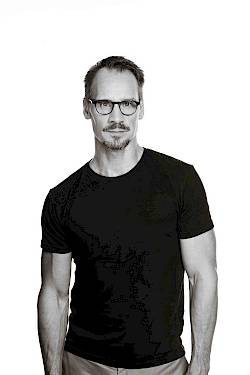
Christian Spuck,
Christian Spuck
Christian Spuck stammt aus Marburg und wurde an der John Cranko Schule in Stuttgart ausgebildet. Seine tänzerische Laufbahn begann er in Jan Lauwers’ Needcompany und Anne Teresa de Keersmaekers Ensemble «Rosas». 1995 wurde er Mitglied des Stuttgarter Balletts und war von 2001 bis 2012 Hauschoreograf der Compagnie. In Stuttgart kreierte er fünfzehn Uraufführungen, darunter die Handlungsballette Lulu. Eine Monstretragödie nach Frank Wedekind, Der Sandmann und Das Fräulein von S. nach E.T.A. Hoffmann. Darüber hinaus hat Christian Spuck mit zahlreichen namhaften Ballettcompagnien in Europa und den USA gearbeitet. Für das Königliche Ballett Flandern entstand 2006 The Return of Ulysses, beim Norwegischen Nationalballett Oslo wurde Woyzeck nach Georg Büchner uraufgeführt. Das Ballett Die Kinder beim Aalto Ballett Essen wurde für den «Prix Benois de la Danse» nominiert, das ebenfalls in Essen uraufgeführte Ballett Leonce und Lena nach Georg Büchner wurde von den Grands Ballets Canadiens de Montréal, dem Charlotte Ballet, USA, dem Tschechischen Nationalballett Prag und vom Stuttgarter Ballett übernommen. Die Uraufführung von Poppea//Poppea für Gauthier Dance am Theaterhaus Stuttgart wurde 2010 von der Zeitschrift «Dance Europe» zu den zehn erfolgreichsten Tanzproduktionen weltweit gewählt sowie mit dem deutschen Theaterpreis Der Faust 2011 und dem italienischen «Danza/Danza-Award» ausgezeichnet. Christian Spuck hat auch Opern inszeniert: Auf Glucks Orphée et Euridice an der Staatsoper Stuttgart folgten Verdis Falstaff am Staatstheater Wiesbaden sowie Berlioz’ La Damnation de Faust und Wagners Fliegender Holländer an der Deutschen Oper Berlin. Von 2012 bis 2023 war Christian Spuck Direktor des Balletts Zürich. Hier waren seine Choreografien Romeo und Julia, Leonce und Lena, Woyzeck, Der Sandmann, Messa da Requiem, Nussknacker und Mausekönig, Dornröschen und Monteverdi zu sehen. Das 2014 in Zürich uraufgeführte Ballett Anna Karenina nach Lew Tolstoi wurde in Oslo, am Moskauer Stanislawski-Theater, vom Koreanischen Nationalballett und vom Bayerischen Staatsballett ins Repertoire übernommen. 2018 hatte in Zürich Spucks Ballett Winterreise Premiere, für das er mit dem «Prix Benois de la Danse 2019» ausgezeichnet wurde. 2019 folgte beim Ballett Zürich Helmut Lachenmanns Das Mädchen mit den Schwefelhölzern (Auszeichnung als «Produktion des Jahres und Kompanie des Jahres für das Ballett Zürich durch die Zeitschrift tanz). Für das Moskauer Bolschoitheater kreierte er 2021 sein Ballett Orlando nach Virginia Woolf. Spucks Messa da Requiem wurde nicht nur zum Adelaide Festival nach Australien eingeladen, sondern auch vom Het Nationale Oper & Ballet Amsterdam und vom Finnischen Nationalballett übernommen. Seit Beginn der Saison 2023/24 ist Christian Spuck Intendant des Staatsballetts Berlin.
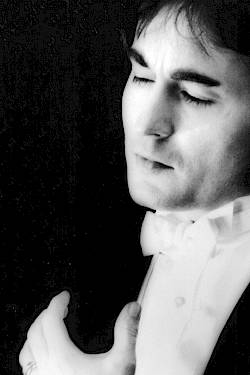
Paul Connelly,
Paul Connelly
Paul Connelly debütierte 23-jährig als Dirigent mit Gershwins Porgy and Bess im Rahmen einer Tournee der Houston Grand Opera. 1980 wurde er auf Einladung von Michail Baryshnikov Erster Kapellmeister des American Ballet Theatre und arbeitete dort mit Choreografen wie Jerome Robbins, George Balanchine und Anthony Tudor. Während dieser Zeit dirigierte er auch Vorstellungen des New York City Ballet sowie Gala-Veranstaltungen wie Nureyev and Friends und Baryshnikov and Co., ausserdem war er Gastdirigent beim National Ballet of Canada. Während der Zeit beim ABT war er an zahlreichen Film- und Fernsehprojekten beteiligt (u.a. Don Quixote). Zu seinen Opernaktivitäten in dieser Zeit gehören Brittens Death in Venice, Debussys Pelléas et Mélisande sowie Purcells Dido and Aeneas. Nach der musikalischen Leitung einer Ballettgala an der Wiener Staatsoper wurde ihm dort Rossinis Barbiere di Siviglia anvertraut, ein Erfolg, der den Anfang einer intensiven Dirigententätigkeit in Europa markiert. Einladungen führten ihn zum Staatsballett Berlin, das Ballett der Opéra Paris (Verfilmungen von Neumeiers Sylvia, Balanchines Jewels, Giselle, Roland-Petit-Abend), zum Orchestre Colonne in Paris, an das Opernhaus Nizza, ans Teatro di San Carlo in Neapel, an die Oper Oslo, zum Royal Ballet in London und in Birmingham, zum Het Nationale Ballet in Amsterdam, zum Tokyo Ballet, zum Semperoper Ballett Dresden und an die Mailänder Scala, wo er auf Einladung von Riccardo Muti die Opern Il turco in Italia, Die Zauberflöte und Don Giovanni dirigierte. An der Scala leitete er auch eine Reihe von Ballettaufführungen, unter anderem Giselle, die auch verfilmt wurde. Auf DVD erschienen Mauro Bigonzettis Caravaggio mit dem Staatsballett Berlin und Nureyews Nussknacker mit dem Ballett der Wiener Staatsoper. Unlängst dirigierte er Kenneth MacMillans Mayerling an der Staatsoper Budapest. Geplant sind The Cellist von Cathy Marston beim Ballett Zürich sowie eine Neuproduktion von Coppélia in der Choreografie von Alexei Ratmansky an der Mailänder Scala.

Rufus Didwiszus,
Rufus Didwiszus
Rufus Didwiszus studierte Bühnen- und Kostümbild in Stuttgart bei Jürgen Rose und arbeitet seither als freier Bühnenbildner in Theater-, Opern- und Tanzproduktionen, u. a. mit Barrie Kosky (La Belle Hélène, Die Perlen der Cleopatra und Anatevka an der Komischen Oper Berlin; La fanciulla del West, Die Gezeichneten und Boris Godunow am Opernhaus Zürich; Orphée aux enfers, Salzburger Festspiele; Fürst Igor, Opéra de Paris; Der Rosenkavalier, Bayerische Staatsoper), Thomas Ostermeier (u. a. Shoppen &Ficken in der Baracke des Deutschen Theaters Berlin mit Einladung zum Berliner Theatertreffen und nach Avignon; Der blaue Vogel am Deutschen Theater, Feuergesicht am Schauspielhaus Hamburg, Der Name bei den Salzburger Festspielen und an der Berliner Schaubühne, The Girl on the Sofa beim Edinburgh International Festival und an der Schaubühne, Vor Sonnenaufgang an den Münchner Kammerspielen), Sasha Waltz, Tom Kühnel, Christian Stückl, Stefan Larsson, Tomas Alfredson und Christian Lollike. Seit 2004 entwirft und inszeniert Rufus Didwiszus mit Joanna Dudley eigene Musik-Theater-Performances, u. a. in den Sophiensaelen, an der Schaubühne und im Radialsystem in Berlin sowie im BOZAR in Brüssel. Mit seiner Band «Friedrichs» war er in Der weisse Wolf am Staatstheater Stuttgart zu sehen. Zudem war er als Gastdozent an der Akademie der Bildenden Künste München und an der Kunsthochschule Berlin-Weissensee tätig. Für Barrie Kosky entstanden zuletzt die Bühnenbilder zu Rimski-Korsakows Der goldene Hahn an der Komischen Oper Berlin, Das Rheingold am Royal Opera House London sowie Offenbachs Les Brigands an der Opéra National de Paris.

Buki Shiff,
Buki Shiff
Buki Shiff wurde in Israel geboren und studierte an der Universität Tel-Aviv. Seit 1984 ist sie als Bühnen- und Kostümbildnerin für Theater, Film, Fernsehen und Oper in Israel, Europa und den USA tätig. Dabei arbeitet sie regelmässig mit den Regisseuren Barrie Kosky, David Alden, Richard Jones und Robert Carsen zusammen. Zu ihren Arbeiten zählen Ausstattungen für Les Contes d’Hoffmann, Faust, Sweeney Todd, Cavalleria Rusticana, Pagliacci, Boris Godunow, Madama Butterfly und Don Giovanni an der New Israeli Opera Tel Aviv, Tannhäuser, L’Incoronazione di Poppea, Rinaldo, Rodelinda, La Calisto, Orlando und Semiramide an der Bayerischen Staatsoper in München, Lohengrin, Die Meistersinger von Nürnberg, Tristan und Isolde und Der fliegende Holländer an der Berliner Staatsoper, Boris Godunow an der Wiener Volksoper, Tristan und Isolde am Teatro Real Madrid, Lulu an der English National Opera, Wozzeck und Meistersinger an der Welsh National Opera, Candide am Théâtre du Châtelet in Paris und an der Mailänder Scala, Wozzeck und La belle Hélène an der Komischen Oper Berlin, Die Nase am Royal Opera House Covent Garden sowie Die Liebe zu den drei Orangen an der Deutschen Oper Berlin. 2006 wurde Buki Shiff in Tel-Aviv als Bühnen- und Kostümbildnerin des Jahres ausgezeichnet, 2008 erhielt sie den Rosenblum-Preis als Künstlerin des Jahres. 2013 wurde sie bei den International Opera Awards in London als beste Bühnen- und Kostümbildnerin geehrt. Darüber hinaus war sie an Kunstausstellungen in Tel Aviv und Europa beteiligt.

Martin Gebhardt,
Martin Gebhardt
Martin Gebhardt war Lichtgestalter und Beleuchtungsmeister bei John Neumeiers Hamburg Ballett. Ab 2002 arbeitete er mit Heinz Spoerli und dem Ballett Zürich zusammen. Ballettproduktionen der beiden Compagnien führten ihn an renommierte Theater in Europa, Asien und Amerika. Am Opernhaus Zürich schuf er das Lichtdesign für Inszenierungen von Jürgen Flimm, David Alden, Jan Philipp Gloger, Grischa Asagaroff, Matthias Hartmann, David Pountney, Moshe Leiser/Patrice Caurier, Damiano Michieletto und Achim Freyer. Bei den Salzburger Festspielen kreierte er die Lichtgestaltung für La bohème und eine Neufassung von Spoerlis Der Tod und das Mädchen. Seit der Spielzeit 2012/13 ist Martin Gebhardt Leiter des Beleuchtungswesens am Opernhaus Zürich. Eine enge Zusammenarbeit verbindet ihn heute mit dem Choreografen Christian Spuck (u.a. Winterreise, Nussknacker und Mausekönig, Messa da Requiem, Anna Karenina, Woyzeck, Der Sandmann, Leonce und Lena, Das Mädchen mit den Schwefelhölzern). Er war ausserdem Lichtdesigner für die Choreografen Edward Clug (u.a. Strings, Le Sacre du printemps und Faust in Zürich), Alexei Ratmansky, Wayne McGregor, Marco Goecke, und Douglas Lee. Mit Christoph Marthaler und Anna Viebrock arbeitete er beim Händel-Abend Sale und Rossinis Il viaggio a Reims in Zürich sowie bei Lulu an der Hamburgischen Staatsoper zusammen und mit Jossi Wieler und Sergio Morabito an der Oper Genf für Les Huguenots. 2023 gestaltete er das Licht für Spucks Ballett Bovary beim Staatsballett Berlin und 2024 Rossinis Tancredi an den Bregenzer Festspielen. Ausserdem war er Lichtdesigner bei Atonement von Cathy Marston am Opernhaus Zürich.
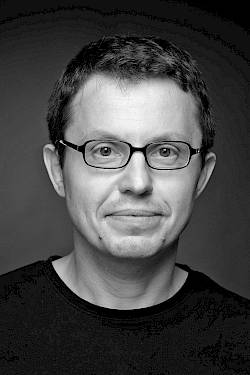
Janko Kastelic,
Janko Kastelic
Janko Kastelic ist ein kanadisch-slowenischer Dirigent, Chorleiter, Pianist und Organist. Er begann seine musikalische Ausbildung in Kanada am Royal/Western Conservatory of Music und der St. Michael’s Choir School. Er hat einen Abschluss in Dirigieren, Komposition und Musiktheorie von der Universität Toronto und setzte sein Studium an der Hochschule für Musik und Darstellende Kunst in Wien fort. Seit 2017 ist er Chordirektor am Opernhaus Zürich. Er war einer der Kapellmeister der Wiener Hofmusikkapelle, Studienleiter des JET-Programms für junge Sänger am Theater an der Wien und Assistent bei den Bayreuther Festspielen sowie Gastchordirektor an der Hamburgischen Staatsoper. Zu den Positionen, die er im Lauf seiner Karriere bekleidet hat, gehört auch die Stelle des Generalmusikdirektors und Operndirektors am Slowenischen Nationaltheater Maribor, des Zweiten Chordirektors an der Wiener Staatsoper sowie des Korrepetitors an der Opéra National de Paris. Er war Assistenzprofessor an der Universität Ljubljana und Mentor an der Musik und Kunst Privatuniversität der Stadt Wien. Seine künstlerischen Leistungen sind dokumentiert auf mehreren Live-Aufnahmen, darunter Tschaikowskis Pique Dame und Schönbergs Moses und Aron. Er arrangierte und dirigierte auch Werke für die Feierlichkeiten zum Mozartjahr 2006. Zu seinen Arbeiten beim Klangbogen-Festival in Wien gehört die europäische Erstaufführung von Blochs Macbeth. Janko Kastelic ist auch ein engagierter Pädagoge, der sich der Förderung der nächsten Generation von Musikerinnen und Musikern verschrieben hat.
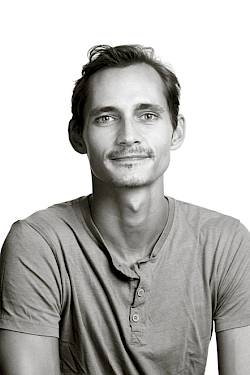
Dominik White Slavkovský,
Dominik White Slavkovský
Dominik White Slavkovský is Slovakian. Trained at the Bratislava Dance Conservatory, he danced for five years in the Ballet of the Slovak National Theater in Bratislava, most recently as a semi-soloist. He has been a member of Ballett Zürich since the 2014/15 season. In choreographies by Christian Spuck he performed the title role of "Woyzeck", as Drosselmeier in "Nutcracker and Mouse King", Coppelius in "The Sandman", Paris in "Romeo and Juliet" and as Death in Edward Clug's "Peer Gynt". He has also danced in choreographies by George Balanchine, Uwe Scholz, Alexei Ratmansky, Jiří Kylián, William Forsythe, Crystal Pite, Hans van Manen, Nacho Duato, Marco Goecke, James Kudelka, Vladimir Malakhov and many others. In the series "Young Choreographers" he showed his pieces "How to save the world", "Conspiracy" and "Boyband"

Jan Casier,
Jan Casier
Jan Casier was born in Belgium. He studied at the Royal Ballet School in Antwerp. From 2008 to 2012 he was a member of the Royal Ballet of Flanders where he danced in ballets by John Cranko, William Forsythe, David Dawson and Christian Spuck. He appeared in David Dawson’s Faun(e) as a guest at the English National Ballet. From 2012 to 2014 he was a member of Ballett Zürich, where he performed roles in numerous Christian Spuck ballets, including Leonce in Leonce und Lena, Paris in Romeo und Julia and the title role of Woyzeck. He also danced in choreographies by Edward Clug, Sol León/Paul Lightfoot, Marco Goecke and Wayne McGregor. From 2014 to 2016 he was a member of the Semperoper Ballett Dresden. There he performed in choreographies by Aaron Watkins (Prince in The Nutcracker), William Forsythe, Alexei Ratmansky, David Dawson and Alexander Ekman. Jan Casier returned to Ballett Zürich in 2016. Since his return, he has danced in Forsythe’s Quintett, Godani’s rituals from another when and the title role in Edward Clug’s Faust and Marco Goecke’s Nijinski. He also appeared as Drosselmeier in Christian Spuck’s Nussknacker und Mausekönig. In 2019, he was named «Dancer of the Year» by the «tanz» magazine and was awarded the «Tanzpreis der Freunde des Balletts Zürich».
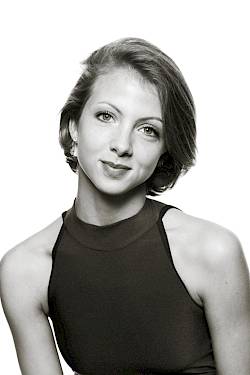
Michelle Willems,
Michelle Willems
Michelle Willems is French. She studied at the Bolshoi Ballet Academy and at the Atelier Rudra-Béjart in Lausanne. After two seasons with the Junior Ballett, she joined Ballett Zürich in the 2016/17 season. After solo roles in Giselle and Schwanensee, she danced Kitty in Christian Spuck’s Anna Karenina, Marie in Spuck’s Nussknacker und Mausekönig and Gretchen in Edward Clug’s Faust, and in Spuck’s Das Mädchen mit den Schwefelhölzern. She has also appeared in choreographies by William Forsythe, Jiří Kylián, Marco Goecke, Crystal Pite, George Balanchine, Ohad Naharin, Douglas Lee, and Filipe Portugal She was awarded the «Tanzpreis der Freunde des Balletts Zürich» in 2018.
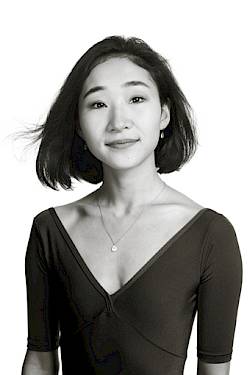
Meiri Maeda,
Meiri Maeda
Meiri Maeda is Japanese. She received her training at the Nobuko Okamoto Ballet Academy, at the Kirov Academy of Ballet in Washington and at the Académie Princesse Grace in Monte-Carlo. After two seasons with the Junior Ballett, she joined Ballett Zürich in the 2016/17 season. She has appeared as Marie in Christian Spuck’s Nussknacker und Mausekönig, in Forsythe’s The Second Detail, One Flat thing, reproduced, and In the middle, in Ratmansky’s Schwanensee reconstruction (4 small swans), in Emergence by Crystal Pite, and Bella Figura by Jiří Kylián.

Daniel Mulligan,
Daniel Mulligan
Daniel Mulligan comes from Great Britain and studied at the Royal Ballet School in London. After two seasons with the Junior Ballett, he joined Ballett Zürich in the 2009/10 season. He has appeared as a soloist in many of Heinz Spoerli’s choreographies. He danced Mercutio/Benvolio in Christian Spuck’s Romeo und Julia as well as in ballets by Mats Ek (Dornröschen), Hans van Manen (Solo, Kammerballett), Edward Clug (Chamber Minds, Le Sacre du printemps), Sol León/Paul Lightfoot (Skew-Whiff, Speak for Yourself), William Forsythe (Quintett), Jiří Kylián (Gods and Dogs, Stepping Stones, Sweet Dreams), Ohad Naharin (Minus 16), Marco Goecke (Petruschka), Filipe Portugal (Corpus), Douglas Lee, and Crystal Pite. Recent leading roles have included Mephisto in Faust by Edward Clug, Fritz and the Clown in Spuck’s Nussknacker und Mausekönig, as well as Stiva in Spuck’s Anna Karenina.
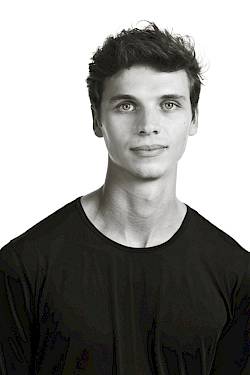
Mark Geilings,
Mark Geilings
Mark Geilings comes from Australia, where he was trained at the Australian Ballet School. He danced with the Leipzig Ballet from 2012-2015, where he performed in choreographies by Uwe Scholz, Mario Schröder (the title role in Otello), Meryl Tankard (Cinderella), Ohad Naharin, and Cayetano Soto. He was a member of Gauthier Dance in Stuttgart for the 2015/16 season, where he performed in Marco Goecke’s Nijinsky. He has been a member of Ballett Zürich since the 2016/17 season, where he has appeared in Petruschka by Marco Goecke, Kammerballett by Hans van Manen, Gods and Dogs by Jiří Kylián, Lady with a Fan by Douglas Lee, and as Mercutio in Spuck’s Romeo und Julia, among others.
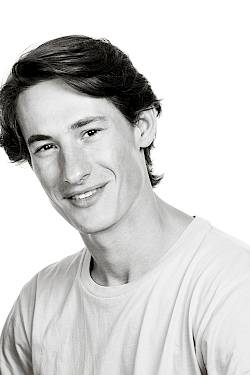
Alexander Jones,
Alexander Jones
Alexander Jones comes from Great Britain. He received his dance training at the Royal Ballet School in London. In 2004 he won the gold medal in the Adeline Genée Competition and the Dame Ninette de Valois Prize. In the 2005/06 season he became a member of the Stuttgart Ballet, where he was appointed principal dancer in 2011/12. In Stuttgart he has appeared as Armand Duval in Neumeier’s Kameliendame, Romeo in Cranko’s Romeo und Julia, in the title roles of Cranko’s Onegin and Kevin O’Days Hamlet, as Basilio in Maximiliano Guerra’s Don Quixote and in MacMillan’s Lied von der Erde. He has also danced in choreographies by Balanchine, Robbins, Ashton, Schaufuss, Tetley, Béjart, Haydée, van Manen, Forsythe, Lee, McGregor, Clug, and Spuck. Alexander Jones has been a first soloist of Ballett Zürich since the 2015/16 season. Here he has danced Prince Siegfried in Alexei Ratmansky’s Schwanensee reconstruction, Albrecht in Patrice Bart’s Giselle and Romeo in Romeo und Julia, Nathanael in Der Sandmann and Vronsky in Anna Karenina (all by Christian Spuck), among others.
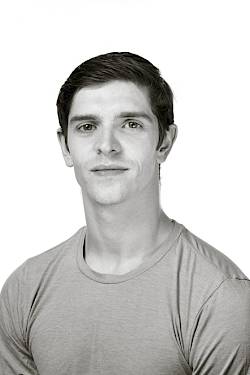
Matthew Knight,
Matthew Knight
Matthew Knight is British. He completed his training at the Elmhurst School and the Royal Ballet School in London. After a season with the Junior Ballett, he joined Ballett Zürich in the 2014/15 season. He presented Jane Doe and Mocambo as part of the «Junge Choreografen» series. He has danced in choreographies by Mats Ek (Cavalier in Dornröschen), William Forsythe, Marco Goecke (Moor in Petruschka), Jiří Kylián, Douglas Lee, Sol León/Paul Lightfoot, Hans van Manen, Wayne McGregor, Ohad Naharin, Crystal Pite, and Filipe Portugal. He was Leonce in Christian Spuck’s Leonce und Lena, Nathanael in Spuck’s Der Sandmann and the Clown in Spuck’s Nussknacker und Mausekönig. In 2018 he also appeared as the title roles in Edward Clug’s Faust and in Marco Goecke’s Nijinski. In 2016 he was awarded the «Tanzpreis der Freunde des Balletts Zürich».
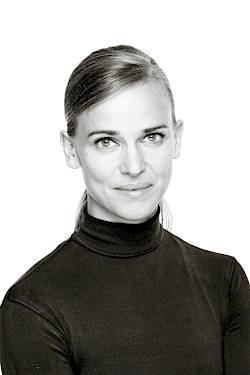
Katja Wünsche,
Katja Wünsche
Katja Wünsche comes from Dresden and was trained at the Staatliche Ballettschule Berlin. She has won prizes at numerous ballet competitions. From 1999 to 2012 she danced in the Stuttgart Ballet, including as a principal dance from 2006. She danced leading roles in choreographies by John Cranko (Romeo und Julia, Der Widerspenstigen Zähmung, Onegin), John Neumeier (Endstation Sehnsucht, Die Kameliendame), Marcia Haydée (Dornröschen, La Sylphide, La fille mal gardée) and Christian Spuck (Lulu, Der Sandmann, Leonce und Lena, Das Fräulein von S.) and ballets by Forsythe, Kylián, León/Lightfoot and Goecke. In 2007 she was awarded the German Dance Prize Future (for promising young artists) and the German Theater Prize Der Faust. Katja Wünsche has been a first soloist with Ballett Zürich since the 2012/13 season. She has been seen in Zurich as Julia in Spuck’s Romeo und Julia, Lena in Leonce und Lena, Marie in Woyzeck, Anna Karenina and Kitty in Anna Karenina and Clara in Der Sandmann. She has also performed in choreographies by Sol León/Paul Lightfoot, Douglas Lee, Martin Schläpfer, Wayne McGregor and Marco Goecke. In 2014 she was awarded the «Tanzpreis der Freunde des Balletts Zürich».
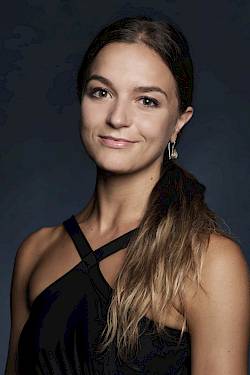
Aurore Aleman Lissitzky,
Aurore Aleman Lissitzky
Aurore Aleman Lissitzky comes from France. She received her training with Monique Loudières, at the Académie Princesse Grace in Monte-Carlo and at the Hamburg Ballet School. In 2008 she won the gold medal at the Concours International de Grasse. At the age of 16 she became a member of the Hamburg Ballet and danced solos in numerous choreographies by John Neumeier. After half a season in the Junior Ballet, she joined the Ballett Zürich in the 2017/18 season. She danced solos in choreographies by Christian Spuck, Edward Clug, Johann Inger, Jiří Kyliáns (Stepping Stones) as well as in Patrice Bart (Peasant Pas-de-deux in Giselle) and William Forsythe (The Second Detail).
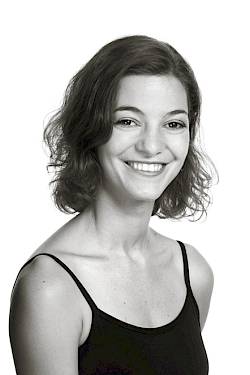
Mélissa Ligurgo,
Mélissa Ligurgo
Mélissa Ligurgo comes from Belgium and studied at the Royal Ballet School in Antwerp. She danced in John Cranko’s Onegin (Tatiana), as well as in ballets by Forsythe, Kylián, Dawson, and Robbins, at the Royal Ballet of Flanders. She appeared in Preljocaj’s Romeo und Julia (Julia) at the Ballett Basel in the 2011/12 season. She has been a member of Ballett Zürich since the 2012/13 season, where has danced Lena in Leonce und Lena by Christian Spuck and Frau Mauserinks in Nussknacker und Mausekönig. She has also appeared in choreographies by Wayne McGregor and Douglas Lee. As part of the «Junge Choreografen» series she presented Mind Games and Klastos together with Giulia Tonelli as well as Individuo.

Greta Calzuola,
Greta Calzuola
Greta Calzuola is Italian. She completed her training at the ballet school of the Umbria Ballet in Italy and at the Académie Princesse Grace in Monte Carlo. She won the International Ballet Competition in Longiano in 2014. This is her second season as a member of the Junior Ballett.

Cohen Aitchison-Dugas,
Cohen Aitchison-Dugas
Cohen Aitchison-Dugas is Canadian. He studied at the École Supérieure de Ballet du Québec and at the National Ballet School in Canada. In the 2015/16 season he danced in The Nutcracker with the Grands Ballets Canadiens. After two seasons with the Junior Ballett, he joined Ballett Zürich in the 2017/18 season. He has performed in Jacopo Godani’s rituals from another when, in Filipe Portugal’s Behind the mirror and danced the role of the Mouse King in Christian Spuck’s Nussknacker und Mausekönig, among others. He was awarded with the «Tanzpreis der Freunde des Balletts Zürich» in 2018.
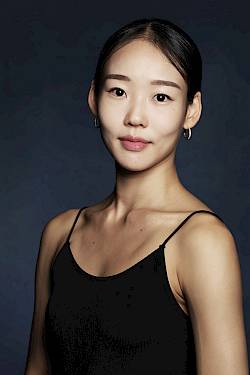
Sujung Lim,
Sujung Lim
Sujung Lim comes from South Korea. She was educated at the Yewon Arts High School and at the Hochschule für Musik und Darstellende Kunst in Mannheim. She was with the Ballett Karlsruhe from 2011-2018, where she performed in Rusalka by Jiří Bubeníček, La Sylphide by Peter Schaufuss, Der Nussknacker by Youri Vamos, Le Sacre du printemps by Terence Kohler, Giselle by Peter Wright and Anne Frank by Reginaldo Oliveira. She won gold medals at the Tanzolymp Berlin in 2008 and 2011. Sujung Lim has been a member of Ballett Zürich since the 2017/18 season.

Rafaelle Queiroz,
Rafaelle Queiroz
Rafaelle Queiroz is from Brazil. She received her training in Rio de Janeiro and, with a stipend from the Tanzstiftung Birgit Keil, at the Akademie des Tanzes in Mannheim. She was a finalist at the «Prix de Lausanne» and won the Langham Award at the Youth American Grand Prix 2009. She was a member of the Badisches Staatsballett Karlsruhe from 2009 to 2019, where roles included Odette/Odile in Schwanensee by Christopher Wheeldon, Myrtha in Giselle by Peter Wright, the title role in La Sylphide by Peter Schaufuss, Katharina/Bianca in Cranko’s Der Widerspenstigen Zähmung, Julia in Kenneth MacMillan’s Romeo und Julia, and the title role in Rusalka von Jiří Bubeníček. In addition, she appeared in choreographies by Hans van Manen, Heinz Spoerli, Davide Bombana and Reginaldo Oliveira. She joined Ballett Zürich with the 2019/20 season.
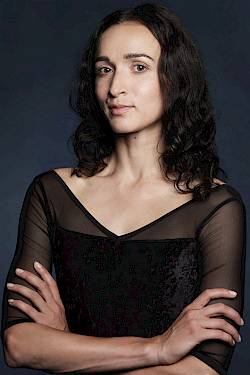
Inna Bilash,
Inna Bilash
Inna Bilash comes from Ukraine. She studied ballet at the Kharkov Choreographic School, the Perm State Choreographic College and the Perm State Academy of Arts and Culture. She was a principal dancer in the Perm Ballet, where she appeared as Julia in Kenneth MacMillan’s Romeo und Julia, Odette/Odile in Natalia Makorova’s Schwanensee, Giselle in the choreography of Perrot/Coralli/Petipa, the Bride in Kylián’s Les Noces and Masha in MacMillan’s Winter Dreams. She has also appeared as a soloist in choreographies by Jerome Robbins, George Balanchine and Douglas Lee. She won the Arabesque Competition in Perm and the Bolshoi Ballet Television Competition. In 2017 she was awarded the prize from the ballet magazine «The Soul of Dance». Inna Bilash has been a member of Ballett Zürich since the 2018/19 season and has appeared in a variety of roles, including as the title role in Patrice Bart’s Giselle.


